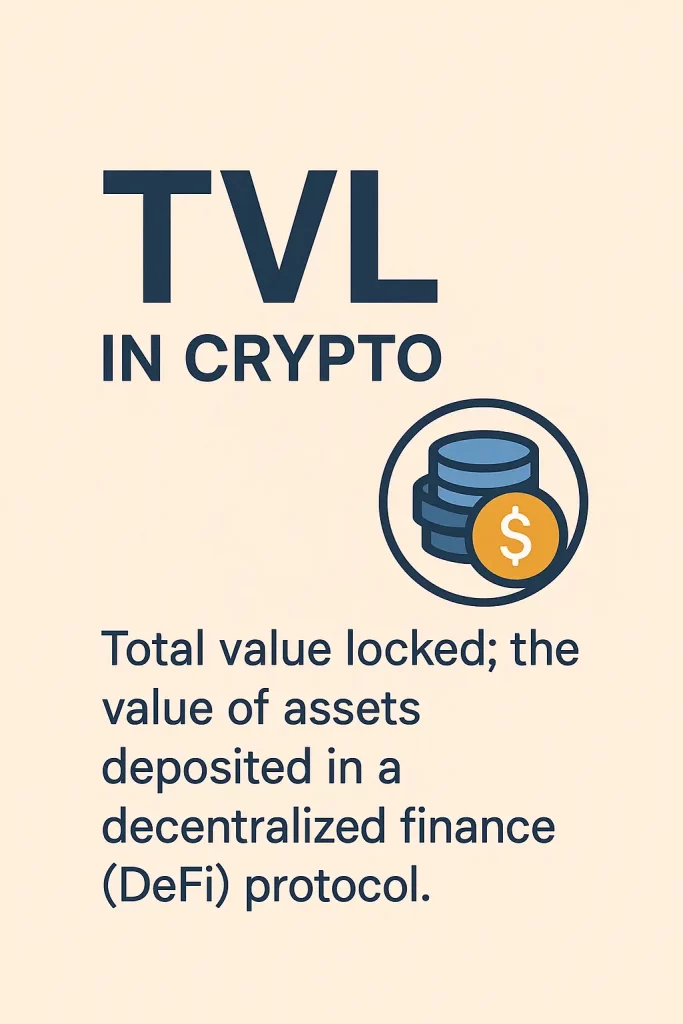TVL in Crypto - Meaning, Importance & Calculation
Understanding Total Value Locked (TVL) in the world of cryptocurrency and decentralized finance (DeFi) is essential for anyone looking to navigate this complex and rapidly evolving space. In this article, we’ll explore what TVL means, how it’s calculated, why it’s important, and what constitutes a healthy TVL. We’ll also address common misconceptions about TVL to ensure you have a clear and accurate understanding. By the end, you’ll be equipped with the knowledge to evaluate DeFi protocols more effectively.

What Does TVL Mean in Crypto?
Total Value Locked (TVL) is a metric that shows the total value of cryptocurrency assets locked in a DeFi protocol’s smart contracts. These assets, such as Ethereum (ETH), Binance Coin (BNB), or stablecoins like USDT, are staked or deposited for activities like lending, borrowing, or providing liquidity on decentralized exchanges (DEXs).
TVL is calculated by multiplying the number of each locked token by its current market price and summing the results. For example, if a protocol holds 5,000 ETH (priced at $2,000 each) and 2 million USDC (at $1 each), its TVL is $10 million from ETH plus $2 million from USDC, totaling $12 million.
This metric provides a snapshot of the capital committed to a protocol, often tracked by platforms like DefiLlama or DeFi Pulse. TVL varies across protocols and blockchains, reflecting the scale of assets involved in DeFi activities.
How Is Crypto TVL Calculated?
To understand a DeFi protocol’s TVL, you need to know how it’s calculated. The formula is straightforward:
[ \text{TVL} = \sum (\text{Number of Tokens Locked} \times \text{Current Price Per Token}) ]
For example, imagine a lending platform with 8,000 ETH locked (at $2,500 each) and 3 million DAI (at $1 each). The calculation is:
ETH value: ( 8,000 \times 2,500 = 20,000,000 ) USD
DAI value: ( 3,000,000 \times 1 = 3,000,000 ) USD
Total TVL: ( 20,000,000 + 3,000,000 = 23,000,000 ) USD
The TVL is $23 million. This value is typically reported in USD for consistency, as token prices fluctuate. You can find TVL data for individual protocols or entire blockchains on aggregators like DefiLlama, which pull real-time data from smart contracts.
Why Is TVL Important in DeFi?
TVL is a critical indicator of a DeFi protocol’s market position and utility. A high TVL suggests a protocol holds significant capital, often reflecting its dominance in the DeFi space. For example, Ethereum’s DeFi ecosystem, with a TVL of $61.5 billion, leads over competitors like Tron at $10.5 billion.
As an investor, you can use TVL to compare protocols and gauge their market share. A protocol with a large TVL, like Curve, may attract more users due to its established presence, driving further growth. TVL also informs your investment decisions by highlighting protocols with substantial capital, which may indicate lower risk, though not guaranteed.
Also, TVL impacts a protocol’s functionality. In DEXs, higher TVL means larger liquidity pools, enabling you to trade larger amounts with less price impact. In lending platforms, it supports more borrowing options and competitive interest rates. However, you should pair TVL with other metrics, like security audits and governance, to fully assess a protocol’s potential.
What Is a Good TVL in Crypto?
A “good” TVL depends on the protocol’s context, but benchmarks help you evaluate its standing. Established protocols like Curve ($1.8 billion) or Aave ($3.2 billion) set a high bar, as their TVLs reflect widespread adoption (DefiLlama). For newer protocols, reaching $1 billion is a notable milestone, signaling growing user commitment.
Compare TVL across similar protocols to judge performance. For instance, in lending platforms, Aave’s TVL outpaces smaller competitors, indicating stronger market presence. You should also consider TVL growth trends—rapid increases suggest rising popularity, while stagnation may raise concerns.
Blockchains provide another benchmark. Ethereum’s $61.5 billion TVL dwarfs BNB Chain’s $4.5 billion, showing ecosystem scale. However, a high TVL alone isn’t enough; you must check transaction volume and user activity to confirm a protocol’s vitality.
| Protocol/Blockchain | TVL (USD) | Context |
|---|---|---|
| Ethereum | $61.5 billion | Largest DeFi ecosystem |
| Curve | $1.8 billion | Leading DEX protocol |
| Aave | $3.2 billion | Top lending platform |
| BNB Chain | $4.5 billion | Growing DeFi hub |
Common Misconceptions About TVL
TVL is often misunderstood, leading to flawed assumptions. First, TVL is not market capitalization. Market cap measures a token’s total circulating value, while TVL tracks only assets locked in a protocol. A protocol with a high TVL may have a low market cap if its token supply is small.
Second, a high TVL doesn’t ensure success. Some protocols inflate TVL through short-term incentives, like high yield farming rewards, which may not last. Manipulation, such as wash staking (repeatedly locking/unlocking assets), can also skew figures.
Third, TVL doesn’t reflect profitability. A protocol with billions in TVL may incur losses if operational costs exceed revenue. You should examine revenue streams and costs alongside TVL.
Finally, TVL fluctuates with market prices. A drop in ETH’s price can lower a protocol’s TVL without any change in locked assets, so you shouldn’t overreact to short-term changes. Use platforms like CoinGecko to track TVL trends and avoid these pitfalls.
What Is a Healthy TVL?
A healthy TVL indicates a protocol’s long-term stability and utility. Protocols like Lido ($4.1 billion) exemplify this, balancing high TVL with sustainable growth. Here are key factors to consider:
TVL/Market Cap Ratio: A balanced ratio (e.g., TVL close to or exceeding market cap) suggests efficient token utilization. An overly high market cap relative to TVL may indicate overvaluation.
Sustainability: Healthy TVL grows steadily without relying on temporary incentives. Sudden spikes followed by drops signal instability.
Liquidity: High TVL supports robust liquidity, ensuring smooth transactions and lending. Lido’s TVL, for instance, bolsters its staking services.
Market Dominance: Protocols with a significant share of DeFi’s total TVL (e.g., Lido’s staking dominance) are often healthier, reflecting user preference.
You should also assess external factors, like protocol security and community governance, to confirm TVL health. A healthy TVL isn’t just about size it’s about consistent, reliable growth.
| Factor | Healthy TVL Indicator |
|---|---|
| TVL/Market Cap Ratio | Balanced, e.g., TVL near market cap |
| Sustainability | Steady growth, no reliance on incentives |
| Liquidity | Supports efficient trading/lending |
| Market Dominance | Significant share of DeFi TVL |
Final Thoughts
TVL is a powerful tool for evaluating DeFi protocols, offering insights into their scale, market position, and stability. By understanding how TVL is calculated, why it matters, and what constitutes a healthy figure, you can make informed decisions. Always combine TVL with other metrics, like security and user engagement, to navigate DeFi confidently.

